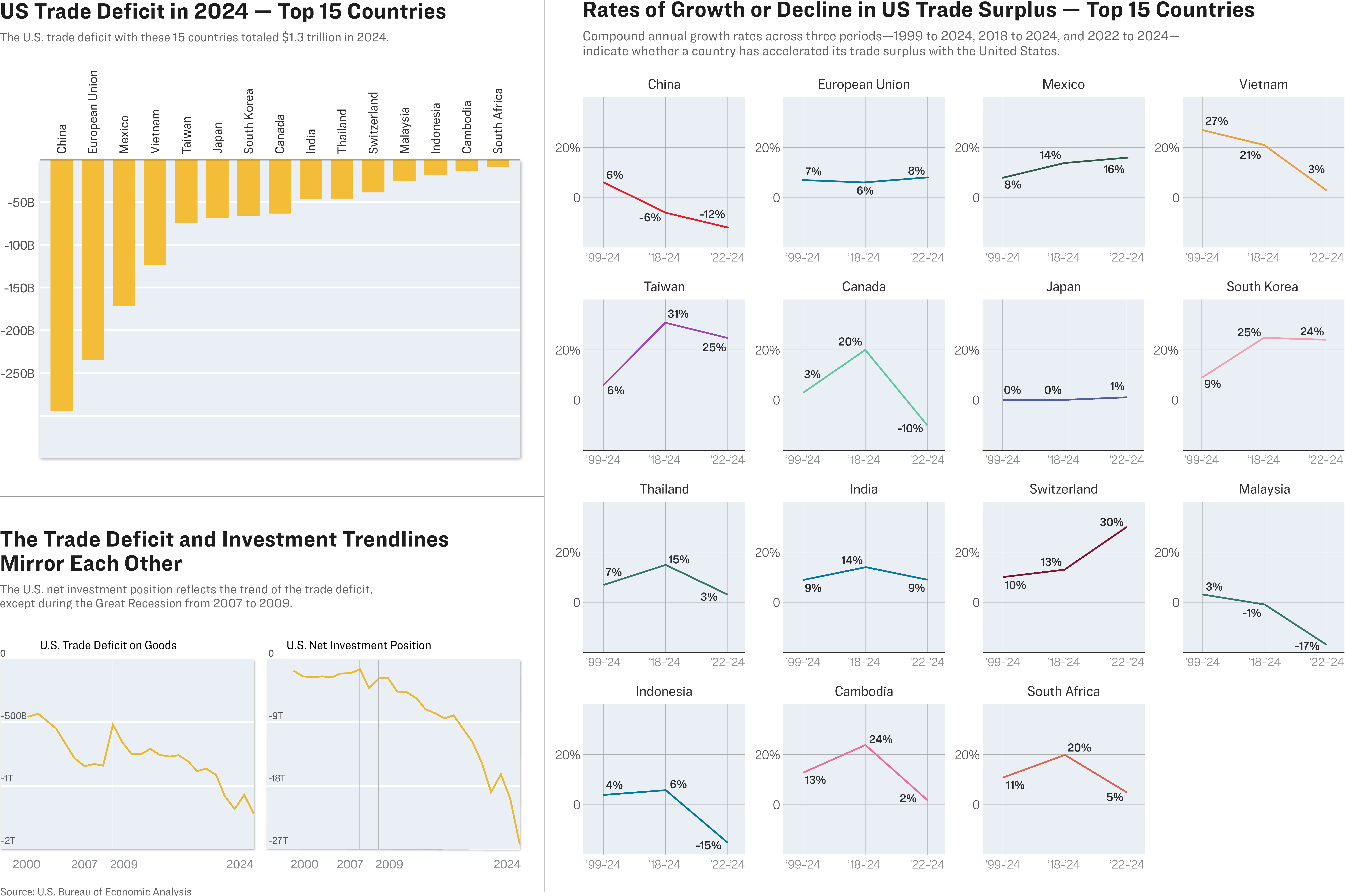Experts say the road to reciprocity will be bumpy but necessary. One, in particular, expects to see early signs of an economic boom before the 2026 midterms.

President Donald Trump has dubbed April 2, when he will unveil reciprocal tariffs to level the trading field between the United States and its 200 partners, “Liberation Day.”
The White House has yet to disclose details of the sweeping tariffs. Treasury Secretary Scott Bessent has said that the administration will focus on the “dirty 15,” or the top 15 percent of partners contributing the most to the United States’ negative trade balance.
Meanwhile, the 25 percent tariff on autos and auto parts unveiled on March 26, which also takes effect on April 2, may foreshadow the magnitude of change that Trump’s reciprocal tariff policy aims to achieve.
A U.S. trade policy investigation, ordered by Trump on day one of his administration, is due to be completed on April 1.
Trump tasked the Office of the United States Trade Representative (USTR) and the Commerce and Treasury departments to identify violators of fair trade policies.
Experts say the journey to reciprocity will be bumpy but necessary, because no partners will voluntarily give up their longstanding trade surpluses with the United States.
According to the experts, however, the United States will ultimately be better off. In the meantime, the administration will likely adjust its plan to a more refined tariff regime tailored to the modern trade world.
“In terms of whether they will eventually blunder their way into a more sophisticated, appropriate tariff, I would say the chances of that happening are probably two out of three,” economist Ian Fletcher told The Epoch Times. “But maybe [they] won’t. You never know with this guy.”
Frank Xie, a professor of business and marketing at the University of South Carolina–Aiken, is more confident about the outcome. He predicts an economic boom before the 2026 midterms, with early signs to appear in the next 12 to 18 months.
‘Mandated Reciprocity’
The United States has kept tariffs low for decades. However, the country is in a different position than in the 1970s, when the trade deficit first appeared.
Its share of the global gross domestic product (GDP) has declined. According to the Social Progress Index, Americans’ quality of life has also undergone an “accelerated decline” since 2018.
The United States has suffered decades of wealth loss, said former U.S. trade representative Ambassador Robert Lighthizer.
He said it’s not a problem when a country runs a trade deficit with another over a short period. However, decades of deficit to the tune of hundreds of billions of dollars—as is the case of the United States’ trade with China—is essentially a “net transfer of wealth,” he told The Epoch Times in a previous interview.
Recent releases of official economic data reflect the outcome of the reduction in U.S. wealth.
Last year, the U.S. trade deficit reached more than $1.2 trillion—the most ever in history.
The Trade Deficit and Investment Trendlines Mirror Each Other
The U.S. net investment position reflects the trend of the trade deficit, except during the Great Recession from 2007 to 2009.
U.S. Trade Deficit on Goods
U.S. Net Investment Position20002024−2T−2T−2T−2T−1T−1T−900B−900B−600B−600B−300B−300B00−30T−30T−25T−25T−20T−20T−15T−15T−10T−10T−5T−5T00
Chart: The Epoch TimesSource: U.S. Bureau of Economic AnalysisCreated with Datawrapper
China Accounted for Nearly Half of US Trade Deficit, 2013–2018
China’s share of the total U.S. trade deficit has declined since 2018, when President Donald Trump began imposing tariffs on Chinese imports.10203040%
At the same time, Americans owe the rest of the world $26 trillion more than what they own in foreign countries, as indicated by the U.S. net investment position in data released last week by the U.S. Bureau of Economic Analysis. The 2024 number represents a 30 percent year-on-year drop.
Much of the world’s investment in the United States is debt. Last year, the U.S. debt reached a record high of more than $36 trillion, or more than $230,000 in debt per taxpayer. The interest payment alone was more than $1 trillion—more than one-fifth of the federal government’s revenue.
The federal deficit in 2024 was nearly $2 trillion, which grew about 8 percent from 2023, according to the U.S. Treasury. The last time Washington had a surplus was 24 years ago.
Economists generally view debt as a tool for a country’s fiscal management; therefore, it is not seen as inherently bad. However, the increasingly high level of debt is concerning.
The U.S. government doesn’t have an unlimited runway to borrow money, Xie said, so the administration needs to act fast.
Historian Victor Davis Hanson describes Trump’s theme as “mandated reciprocity.”
“The United States is not rich or powerful enough anymore to subsidize the economies and militaries of its friends, or to ignore and sluff off the aggression of its enemies,” the Hoover Institution fellow said. Hanson is also a contributor to The Epoch Times.
Regarding the effects of reciprocal tariffs, he said, “Neither our friends, the EU, nor our enemies, like China, will continue to pile up huge trade surpluses by the use of asymmetrical mercantile protectionism.”
Trump has said his team would consider tariff and non-tariff trade barriers when determining the reciprocal tariffs.
In addition to high duty rates, many countries make it difficult for foreign companies to enter their markets via regulatory preference and subsidies for domestic businesses.
On March 31, the USTR released its annual report detailing, by country, trade barriers in 14 categories, including import policies, government procurement processes, subsidies, and favoritism to state-owned enterprises.
At the same time, many foreign businesses trade in the open U.S. market with few barriers. No foreign governments or enterprises will voluntarily give up such privileges, Xie said, so the Trump administration will have to intervene.

The national debt clock displayed at a bus station in Washington on Jan. 2, 2025. Madalina Vasiliu/The Epoch Times
‘Dirty 15’
Taking the approach of “dirty 15” is a “matter of prioritization” to manage the implementation of the reciprocal policy, Xie said.
He cited the 80–20 rule in business, which states that usually 80 percent of the problem is caused by 20 percent of the players. In this case, he said, the administration has identified the top 15 percent who have contributed to a majority of the imbalance.
The White House has yet to release its “dirty 15” country list. However, official data show that the 15 trade partners holding the highest trade surpluses with the United States are: China, the European Union, Mexico, Vietnam, Taiwan, Canada, Japan, South Korea, Thailand, India, Switzerland, Malaysia, Indonesia, Cambodia, and South Africa.
The Epoch Times reviewed the growth rate of the U.S. trade deficit with these 15 trade partners from 1999 to 2024, focusing on the milestone years of 2018 and 2022. Trump imposed tariffs for the first time in 2018, and 2022 is the first year when the pandemic impact should largely have subsided.
If the trend line goes up, as in the case of the European Union and Mexico, the partner has accelerated the growth of its trade surplus with the United States in recent years. If the trend line goes down, as in the case of China, the U.S. trade deficit with the country has slowed down, although there’s still a negative trade balance.
While China is still number one in terms of the size of its trade surplus with the United States, its share of the total halved from about 50 percent in 2018 to 25 percent in 2024. However, this doesn’t necessarily mean the U.S. supply chain’s reliance on China has decreased.
In many instances, the supply chain has simply moved from China to a third country, but Chinese companies are still directing the manufacturing.
“You’re moving production away from China, but the United States is still dependent on corporations under the control of a hostile regime,” said Fletcher, who also sits on the advisory board of the Coalition for a Prosperous America, an advocacy organization exclusively representing manufacturers that have production in the United States.
Basing manufacturing in the United States would eliminate that risk, said Fletcher, and that’s what Trump’s policies are aiming for.
When asked about automakers’ reactions to the new 25 percent tariffs, Trump said: “It depends on whether or not they have factories here. I can tell you, if they have factories here, they’re thrilled.
“If you don’t have factories here, they’re going to have to get going and build them because otherwise, they have to pay tariffs. Very simple.”

Shipping containers are stacked at the Port of Long Beach in Long Beach, Calif., on March 4, 2025. President Donald Trump is set to unveil broader reciprocal tariffs aimed at leveling trade with 200 countries on April 2. Frederic J. Brown/AFP via Getty Images
Prices Will Rise, Then What?
Some specifics about the new auto and auto parts tariffs are still up in the air, according to Mark Tallow, a partner with trade law firm Sandler, Travis, and Rosenberg, in the company’s podcast, “Two Minutes in Trade.” However, based on the specific directions in the implementation process, he said the tariffs don’t look temporary.
The president also said the duties are “permanent.”
Fletcher said that is Trump’s signature style: “Everything he does, he does this big, blunt move. And then they start making adjustments afterwards.”
Xie said he doesn’t believe that Trump will give concessions on the newly announced auto tariffs.
The president, he said, wants the tariff to generate enough pain—thus incentive—for auto parts manufacturing to move to the States.
Xie said he expects the automakers to push their parts suppliers to move to the United States. He added that if 25 percent is not enough, Trump could always add another 5 or 10 percent.
Prices of cars will inevitably go up, Fletcher said. “The question is going to be how upset the public gets about this.”
Trump has anticipated that foreign automakers will raise their car prices.
“I couldn’t care less if they raise prices because people are going to start buying American-made cars,” he told NBC News on March 29.
“I couldn’t care less. I hope they raise their prices, because if they do, people are going to buy American-made cars. We have plenty.”


